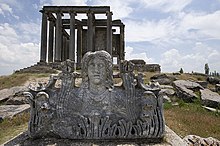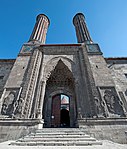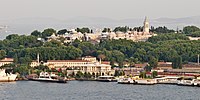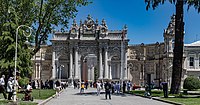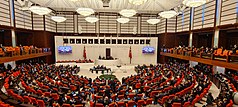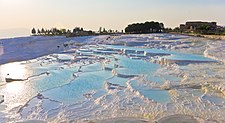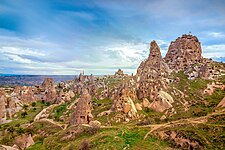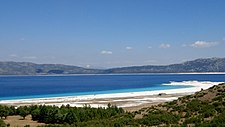
A | B | C | D | E | F | G | H | CH | I | J | K | L | M | N | O | P | Q | R | S | T | U | V | W | X | Y | Z | 0 | 1 | 2 | 3 | 4 | 5 | 6 | 7 | 8 | 9
Republic of Türkiye Türkiye Cumhuriyeti (Turkish) | |
|---|---|
| Anthem: İstiklal Marşı "Independence March" | |
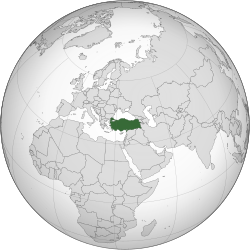 | |
| Capital | Ankara 39°55′N 32°51′E / 39.917°N 32.850°E |
| Largest city | Istanbul 41°1′N 28°57′E / 41.017°N 28.950°E |
| Official languages | Turkish[1][2] |
| Spoken languages |
|
| Ethnic groups (2016)[4] | |
| Demonym(s) |
|
| Government | Unitary presidential republic |
| Recep Tayyip Erdoğan | |
| Cevdet Yılmaz | |
| Numan Kurtulmuş | |
| Kadir Özkaya | |
| Legislature | Grand National Assembly |
| Establishment | |
| c. 1299 | |
| 19 May 1919 | |
| 23 April 1920 | |
| 1 November 1922 | |
| 24 July 1923 | |
| 29 October 1923 | |
| 9 November 1982[5] | |
| Area | |
• Total | 783,562 km2 (302,535 sq mi) (36th) |
• Water (%) | 2.03[6] |
| Population | |
• December 2023 estimate | |
• Density | 111[7]/km2 (287.5/sq mi) (83rd) |
| GDP (PPP) | 2024 estimate |
• Total | |
• Per capita | |
| GDP (nominal) | 2024 estimate |
• Total | |
• Per capita | |
| Gini (2019) | medium |
| HDI (2022) | very high (45th) |
| Currency | Turkish lira (₺) (TRY) |
| Time zone | UTC+3 (TRT) |
| Calling code | +90 |
| ISO 3166 code | TR |
| Internet TLD | .tr |
Turkey,[a] officially the Republic of Türkiye,[b] is a country mainly in Anatolia in West Asia, with a smaller part called East Thrace in Southeast Europe. It borders the Black Sea to the north; Georgia, Armenia, Azerbaijan, and Iran to the east; Iraq, Syria, and the Mediterranean Sea (and Cyprus) to the south; and the Aegean Sea, Greece, and Bulgaria to the west. Turkey is home to over 85 million people; most are ethnic Turks, while ethnic Kurds are the largest ethnic minority.[4] Officially a secular state, Turkey has a Muslim-majority population. Ankara is Turkey's capital and second-largest city; Istanbul is its largest city, and its economic and financial center, as well as the largest city in Europe. Other major cities include İzmir, Bursa and Antalya.
Human habitation began in the Late Paleolithic.[11] Home to important Neolithic sites like Göbekli Tepe and some of the earliest farming areas, present-day Turkey was inhabited by various ancient peoples.[12][13][14] Hattians were assimilated by the incoming Anatolian peoples.[15][16] Increasing diversity during Classical Anatolia transitioned into cultural Hellenization following the conquests of Alexander the Great;[17][18] Hellenization continued during the Roman and Byzantine eras.[19][20] The Seljuk Turks began migrating into Anatolia in the 11th century, starting the Turkification process.[20][21] The Seljuk Sultanate of Rum ruled Anatolia until the Mongol invasion in 1243, when it disintegrated into Turkish principalities.[22] Beginning in 1299, the Ottomans united the principalities and expanded; Mehmed II conquered Istanbul in 1453. During the reigns of Selim I and Suleiman the Magnificent, the Ottoman Empire became a global power.[23][24] From 1789 onwards, the empire saw major transformation, reforms, and centralization while its territory declined.[25][26]
In the 19th and early 20th centuries, persecution of Muslims during the Ottoman contraction and in the Russian Empire resulted in large-scale loss of life and mass migration into modern-day Turkey from the Balkans, Caucasus, and Crimea.[27] Under the control of the Three Pashas, the Ottoman Empire entered World War I in 1914, during which the Ottoman government committed genocides against its Armenian, Greek and Assyrian subjects.[28][29][30] After its defeat, the Ottoman Empire was partitioned.[31] The Turkish War of Independence resulted in the abolition of the sultanate in 1922 and the signing of the Treaty of Lausanne in 1923. The Republic was proclaimed on 29 October 1923, modelled on the reforms initiated by the country's first president, Mustafa Kemal Atatürk. Turkey remained neutral during most of World War II,[32] but was involved in the Korean War. Coups in 1960 and 1980 interrupted the transition to a multi-party system.[33]
Turkey is an upper-middle-income and emerging country; its economy is the 18th- or 11th-largest in the world. It is a unitary presidential republic. Turkey is a founding member of the OECD, G20, and Organization of Turkic States. With a geopolitically significant location, Turkey is a regional power[34] and an early member of NATO. An EU-candidate, Turkey is part of the EU Customs Union, CoE, OIC, and TURKSOY. Turkey has coastal plains, a high central plateau, and various mountain ranges; its climate is temperate with harsher conditions in the interior.[35] Home to three biodiversity hotspots,[36] Turkey is prone to frequent earthquakes and is highly vulnerable to climate change.[37][38] Turkey has universal healthcare, growing access to education,[39] and increasing innovativeness.[40] It is a leading TV content exporter.[41] With 21 UNESCO World Heritage sites, 30 UNESCO intangible cultural heritage inscriptions,[42] and a rich and diverse cuisine,[43] Turkey is the fourth most visited country in the world.
Name
The name Turkey appears in Western sources after the late 11th century, referring to the Seljuk-controlled lands in Anatolia and the Near East.[44] European writers started using Turchia for the Anatolian plateau by the end of the 12th century.[45] The English name Turkey (from Medieval Latin Turchia,Turquia) means "land of the Turks". Middle English usage of Turkye is evidenced in Geoffrey Chaucer's The Book of the Duchess (c. 1369). The modern spelling Turkey dates back to at least 1719.[46] The name Turkey has been used in the texts of numerous international treaties to define the Ottoman Empire.[47][48][49][50]
In Byzantine sources, the name Tourkia (Greek: Τουρκία) was used for defining two medieval states: Hungary (Western Tourkia); and Khazaria (Eastern Tourkia).[51][52]
With the Treaty of Alexandropol, the name Türkiye entered international documents for the first time. In the treaty signed with Afghanistan in 1921, the expression Devlet-i Âliyye-i Türkiyye ('Sublime Turkish State') was used, likened to the Ottoman Empire's name.[53]
In December 2021, President Recep Tayyip Erdoğan issued a circular, calling for exports to be labeled "Made in Türkiye".[54] The circular also stated that in relation to other governmental communications, the "necessary sensitivity will be shown on the use of the phrase 'Türkiye' instead of phrases such as 'Turkey' (in English)".[54][55] The reason given was that Türkiye "represents and expresses the culture, civilization, and values of the Turkish nation in the best way".[54] In May 2022, the Turkish government requested the United Nations and other international organizations to use Türkiye officially in English, which the UN immediately agreed to do.[56][57][58]
History
Prehistory of Anatolia and Eastern Thrace

The Anatolian peninsula, comprising most of modern Turkey, has been inhabited by modern humans since the late Paleolithic period.[60] The European part of Turkey, called Eastern Thrace, has been inhabited since at least 40,000 years ago and is known to have been in the Neolithic era by about 6000 BC.[61] The spread of agriculture from the Middle East to Europe was strongly correlated with the migration of early farmers from Anatolia about 9,000 years ago and was not just a cultural exchange.[62] Anatolian Neolithic farmers derived a significant portion of their ancestry from the Anatolian hunter-gatherers.[63]
Present-day Turkey contains some of the world's oldest Neolithic sites.[60] Göbekli Tepe is the site of the oldest known man-made structure in the world, a temple dating to c. 9600 BC,[59] while Çatalhöyük is a very large Neolithic and Chalcolithic settlement in Anatolia, which existed c. 7500 – c. 5700 BC. It is the largest and best-preserved Neolithic site found to date.[64] The Urfa Man statue is dated c. 9000 BC, to the period of the Pre-Pottery Neolithic, and is defined as "the oldest known naturalistic life-sized sculpture of a human".[65] Troy was first settled in the Neolithic Age, with habitation continuing into the Byzantine period. Troy's Late Bronze Age layers are considered potential historical settings for the later legends of the Trojan War.[66][67][68]
The earliest recorded inhabitants of Anatolia were the Hattians and Hurrians, non-Indo-European peoples who lived in Anatolia as early as c. 2300 BC. Indo-European Hittites came to Anatolia and gradually absorbed the Hattians and Hurrians c. 2000 – c. 1700 BC. Various other ancient Anatolian populations have also lived in Anatolia, from at least the Neolithic until the Hellenistic period.[14] Many of these peoples spoke the Anatolian languages, a branch of the larger Indo-European language family.[69] Given the antiquity of the Indo-European Hittite and Luwian languages, some scholars have proposed Anatolia as the hypothetical centre from which the Indo-European languages radiated.[70] The first empire in the area was founded by the Hittites, from the 18th through the 13th centuries BC. The Assyrians conquered and settled parts of southeastern Turkey as early as 1950 BC[71] although they have remained a minority in the region.[72]
Following the collapse of the Hittite empire c. 1180 BC, the Phrygians, an Indo-European people, achieved ascendancy in Anatolia until their kingdom was destroyed by the Cimmerians in c. 695 BC.[73] The most powerful of Phrygia's successor states were Lydia, Caria and Lycia.
Assyrian king Shalmaneser I (1263–1234 BC) recorded a campaign in which he subdued the entire territory of "Uruatri".[74][75] Urartu re-emerged in Assyrian inscriptions in the 9th century BC.[76] Starting from 714 BC, the Urartu state began to decline and finally dissolved in 590 BC when it was conquered by the Medes.[77]
Antiquity

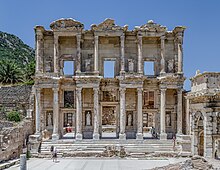
Before 1200 BC, there were four Greek-speaking settlements in Anatolia, including Miletus.[80] Around 1000 BC, Greek migrations to the west coast of Anatolia began; influence of Greek communities were largely limited to these areas until the time of Alexander the Great.[81][82] These settlements were grouped as Aeolis, Ionia, and Doris, after the specific Greek groups that settled them.[83] Numerous important cities were founded by these colonists, such as Ephesus, Halicarnassus, Pergamon, Aphrodisias, Smyrna (now İzmir) and Byzantium (now Istanbul), the latter founded by Greek colonists from Megara in c. 667 BC.[84] Some of these cities, in particular Miletus, went on to found numerous colonies of their own on the coasts of the Black Sea. Miletus was also home to the Ionian school of philosophy, and many of the most prominent pre-Socratic philosophers lived in Miletus. Thales of Miletus is regarded as the first philosopher in the Greek tradition[85][86] and is also historically recognized as the first individual known to have engaged in scientific philosophy.[87][88] Two of the Seven Wonders of the Ancient World, the Temple of Artemis in Ephesus, and the Mausoleum of Halicarnassus, were located in Anatolia.[89]
The Armenian Orontid dynasty, which included parts of what is now eastern Turkey, began in the 6th century BC. In northwestern Turkey, the most significant tribal group in ancient Thrace was the Odyrisians, founded by Teres I.[90]
All of modern-day Turkey was conquered by the Persian Achaemenid Empire during the 6th century BC.[91] The Greco-Persian Wars started when the Greek city-states on the coast of Anatolia rebelled against Persian rule in 499 BC. Queen Artemisia I of Halicarnassus, which was then within the Achaemenid satrapy of Caria, fought as an ally of Xerxes I, King of Persia, against the independent Greek city-states during the second Persian invasion of Greece in 480 BC.[92][93]
Anatolia fell to Alexander the Great in 334 BC,[94] which led to increasing cultural homogeneity and Hellenization in the area,[14] which met resistance in some places.[17] Following Alexander's death in 323 BC, Anatolia was subsequently divided into smaller Hellenistic kingdoms, all of which became part of the Roman Republic by the mid-1st century BC.[95] Hellenization accelerated under Roman rule, and by the early centuries of the Christian Era the local Anatolian languages and cultures had become extinct, being largely replaced by ancient Greek language and culture.[96]
From the 1st century BC up to the 3rd century AD, large parts of modern-day Turkey were contested between the Romans and neighboring Parthians through the Roman-Parthian Wars.
Galatia was an ancient area in the highlands of central Anatolia inhabited by the Celts. The term "Galatians" came to be used by the Greeks for the three Celtic peoples of Anatolia: the Tectosages, the Trocmii, and the Tolistobogii.[97][98] By the 1st century BC the Celts had become so Hellenized that some Greek writers called them Hellenogalatai.[99] The Kingdom of Pontus was a Hellenistic kingdom, centered in the historical region of Pontus and ruled by the Mithridatic dynasty of Persian origin,[100][101][102][103] which may have been directly related to Darius the Great.[104][103] The kingdom was proclaimed by Mithridates I in 281 BC and lasted until its conquest by the Romans in 63 BC. Pontus reached its largest extent under Mithridates VI the Great, who conquered Colchis, Cappadocia, Bithynia, and the Greek colonies of the Tauric Chersonesos. After a long struggle with Rome in the Mithridatic Wars, Pontus was defeated. All ancient regions and territories corresponding to modern Turkey eventually became part of the Roman Empire, and many of them retained their historic names in classical antiquity as Roman provinces.
Early Christian and Roman period

According to the Acts of Apostles,[105] Antioch (now Antakya), a city in southern Turkey, is where the followers of Jesus were first called "Christians". The city quickly became an important center of Christianity.[106][107] The Apostle Paul of Tarsus traveled to Ephesus and stayed there, probably working as a tentmaker.[108] He is claimed to have performed miracles and organized missionary activity in other regions.[109] Paul left Ephesus after an attack from a local silversmith resulted in a pro-Artemis riot.[109]
According to extrabiblical traditions, the Assumption of Mary took place in Ephesus, where Apostle John was also present. Irenaeus writes of "the church of Ephesus, founded by Paul, with John continuing with them until the times of Trajan."[110] While in Ephesus, Apostle John wrote the three epistles attributed to him. The Basilica of St. John near Ephesus, built by Justinian the Great in the 6th century, marks the burial site of Apostle John, while the nearby House of the Virgin Mary is accepted by the Catholic church as the place where Mary, mother of Jesus, lived the final days of her life before her Assumption. Saint Nicholas, born in Patara, lived in nearby Myra (modern Demre) in Lycia.
In 123, Roman emperor Hadrian traveled to Anatolia. Numerous monuments were erected for his arrival, and he met his lover Antinous from Bithynia.[111] Hadrian focused on the Greek revival and built several temples and improved the cities. Cyzicus, Pergamon, Smyrna, Ephesus and Sardes were promoted as regional centres for the Imperial cult during this period.[112]
Byzantine period

After defeating Licinius (the senior co-emperor (augustus) of the East in Nicomedia) at the Battle of Chrysopolis (Üsküdar) in 324 (thus bringing an end to the Tetrarchy system and becoming the sole emperor), Constantine the Great chose the nearby city of Byzantium as the new capital of the Roman Empire and started rebuilding and expanding the city. In 330 he officially proclaimed it as the new Roman capital with the name New Rome (Nova Roma) but soon afterwards renamed it Constantinople (Constantinopolis, modern Istanbul). Under Constantine, Christianity did not become the official religion of the state, but Christianity enjoyed imperial preference since he supported it with generous privileges.

Theodosius the Great made Christianity the official state religion of the Roman Empire with the Edict of Thessalonica in 380. Following the death of Theodosius in 395 and the permanent division of the Roman Empire between his two sons, Constantinople became the capital of the Eastern Roman Empire. This empire, which would later be branded by historians as the Byzantine Empire, ruled most of the territory of present-day Turkey until the Late Middle Ages;[114] although the eastern regions remained firmly in Sasanian hands until the 7th century. The frequent Byzantine-Sassanid Wars, a continuation of the centuries-long Roman-Persian Wars, took place between the 4th and 7th centuries.
Several ecumenical councils of the early Church were held in cities located in present-day Turkey, including the First Council of Nicaea (Iznik) in 325 (which resulted in the first uniform Christian doctrine, called the Nicene Creed), the First Council of Constantinople in 381, the Council of Ephesus in 431, and the Council of Chalcedon in 451.[115] During most of its existence, the Byzantine Empire was one of the most powerful economic, cultural, and military forces in Europe.[116] Established in the Roman period, the Ecumenical Patriarchate of Constantinople is the oldest continuously active institution in Istanbul.[117]
Seljuk and Anatolian beyliks period
According to historians and linguists, the Proto-Turkic language originated in Central-East Asia.[118] Initially, Proto-Turkic speakers were potentially both hunter-gatherers and farmers; they later became nomadic pastoralists.[119] Early and medieval Turkic groups exhibited a wide range of both East Asian and West-Eurasian physical appearances and genetic origins, in part through long-term contact with neighboring peoples such as Iranic, Mongolic, Tocharian, Uralic, and Yeniseian peoples.[120][121][122] During the 9th and 10th centuries CE, the Oghuz were a Turkic group that lived in the Caspian and Aral steppes.[123] Partly due to pressure from the Kipchaks, the Oghuz migrated into Iran and Transoxiana.[123] They mixed with Iranic-speaking groups in the area and converted to Islam.[123] Oghuz Turks were also known as Turkoman.[123]
The Seljuks originated from the Kınık branch of the Oghuz Turks who resided in the Yabgu Khaganate.[124] In 1040, the Seljuks defeated the Ghaznavids at the Battle of Dandanaqan and established the Seljuk Empire in Greater Khorasan.[125] Baghdad, the Abbasid Caliphate's capital and center of the Islamic world, was taken by Seljuks in 1055.[126] Given the role Khurasani traditions played in art, culture, and political traditions in the empire, the Seljuk period is described as a mixture of "Turkish, Persian and Islamic influences".[127] In the latter half of the 11th century, the Seljuk Turks began penetrating into medieval Armenia and Anatolia.[126] At the time, Anatolia was a diverse and largely Greek-speaking region after previously being Hellenized.[18][20][128]
The Seljuk Turks defeated the Byzantines at the Battle of Manzikert in 1071, and later established the Seljuk Sultanate of Rum.[129] During this period, there were also Turkish principalities such as Danishmendids.[130] Seljuk arrival started the Turkification process in Anatolia;[20][131] there were Turkic/Turkish migrations, intermarriages, and conversions into Islam.[132][133] The shift took several centuries and happened gradually.[134][135] Members of Islamic mysticism orders, such as Mevlevi Order, played a role in the Islamization of the diverse people of Anatolia.[136][137] In 13th century, there was a second significant wave of Turkic migration, as people fled Mongol expansion.[138][139] Seljuk sultanate was defeated by the Mongols at the Battle of Köse Dağ in 1243 and disappeared by the beginning of the 14th century. It was replaced by various Turkish principalities.[22][140]
Ottoman Empire

Based around Söğüt, Ottoman Beylik was founded by Osman I in the early 14th century.[141] According to Ottoman chroniclers, Osman descended from the Kayı tribe of the Oghuz Turks.[142] Ottomans started annexing the nearby Turkish beyliks (principalities) in Anatolia and expanded into the Balkans.[143] Mehmed II completed Ottoman conquest of the Byzantine Empire by capturing its capital, Constantinople, on 29 May 1453.[144] Selim I united Anatolia under Ottoman rule.[23] Turkification continued as Ottomans mixed with various indigenous people in Anatolia and the Balkans.[142]
The Ottoman Empire was a global power during the reigns of Selim I and Suleiman the Magnificent.[23][24] In the 16th and 17th centuries, Sephardic Jews moved into Ottoman Empire following their expulsion from Spain.[145] From the second half of the 18th century onwards, the Ottoman Empire began to decline. The Tanzimat reforms, initiated by Mahmud II in 1839, aimed to modernize the Ottoman state in line with the progress that had been made in Western Europe. The Ottoman constitution of 1876 was the first among Muslim states, but was short-lived.[146]

As the empire gradually shrank in size, military power and wealth; especially after the Ottoman economic crisis and default in 1875[147] which led to uprisings in the Balkan provinces that culminated in the Russo-Turkish War (1877–1878); many Balkan Muslims migrated to the empire's heartland in Anatolia,[148][149] along with the Circassians fleeing the Russian conquest of the Caucasus. According to some estimates, 800,000 Muslim Circassians died during the Circassian genocide in the territory of present-day Russia, the survivors of which sought refuge in the Ottoman Empire, mostly settling in the provinces of present-day Turkey. The decline of the Ottoman Empire led to a rise in nationalist sentiment among its various subject peoples, leading to increased ethnic tensions which occasionally burst into violence, such as the Hamidian massacres of Armenians, which claimed up to 300,000 lives.[150]
Ottoman territories in Europe (Rumelia) were lost in the First Balkan War (1912–1913).[151] Ottomans managed to recover some territory in Europe, such as Edirne, in the Second Balkan War (1913). In the 19th and early 20th centuries, persecution of Muslims during the Ottoman contraction and in the Russian Empire resulted in estimated 5 million deaths,[152][153] with more than 3 million in Balkans;[154] the casualties included Turks.[153] Five to seven or seven to nine million refugees migrated into modern-day Turkey from the Balkans, Caucasus, Crimea, and Mediterranean islands,[155] shifting the center of the Ottoman Empire to Anatolia.[156] In addition to a small number of Jews, the refugees were overwhelmingly Muslim; they were both Turkish and non-Turkish people, such as Circassians and Crimean Tatars.[157][158] Paul Mojzes has called the Balkan Wars an "unrecognized genocide", where multiple sides were both victims and perpetrators.[159]
Following the 1913 coup d'état, the Three Pashas took control of the Ottoman government. The Ottoman Empire entered World War I on the side of the Central Powers and was ultimately defeated. During the war, the empire's Armenian subjects were deported to Syria as part of the Armenian genocide. As a result, an estimated 600,000[162] to more than 1 million,[162] or up to 1.5 million[163][164][165] Armenians were killed. The Turkish government has refused to acknowledge[28][166] the events as genocide and states that Armenians were only "relocated" from the eastern war zone.[167] Genocidal campaigns were also committed against the empire's other minority groups such as the Assyrians and Greeks.[168][169][170] Following the Armistice of Mudros in 1918, the victorious Allied Powers sought the partition of the Ottoman Empire through the 1920 Treaty of Sèvres.[171]
Republic of Türkiye

The occupation of Istanbul (1918) and İzmir (1919) by the Allies in the aftermath of World War I initiated the Turkish National Movement. Under the leadership of Mustafa Kemal Pasha, a military commander who had distinguished himself during the Battle of Gallipoli, the Turkish War of Independence (1919–1923) was waged with the aim of revoking the terms of the Treaty of Sèvres (1920).[172]
The Turkish Provisional Government in Ankara, which had declared itself the legitimate government of the country on 23 April 1920, started to formalize the legal transition from the old Ottoman into the new Republican political system. The Ankara Government engaged in armed and diplomatic struggle. In 1921–1923, the Armenian, Greek, French, and British armies had been expelled:[173][174][175][176] The military advance and diplomatic success of the Ankara Government resulted in the signing of the Armistice of Mudanya on 11 October 1922. The handling of the Chanak Crisis (September–October 1922) between the United Kingdom and the Ankara Government caused the collapse of David Lloyd George's Ministry on 19 October 1922[177] and political autonomy of Canada from the UK.[178] On 1 November 1922, the Turkish Parliament in Ankara formally abolished the Sultanate, thus ending 623 years of monarchical Ottoman rule.
The Treaty of Lausanne of 24 July 1923, which superseded the Treaty of Sèvres,[171][172] led to the international recognition of the sovereignty of the new Turkish state as the successor state of the Ottoman Empire. On 4 October 1923, the Allied occupation of Turkey ended with the withdrawal of the last Allied troops from Istanbul. The Turkish Republic was officially proclaimed on 29 October 1923 in Ankara, the country's new capital.[179] The Lausanne Convention stipulated a population exchange between Greece and Turkey.[180]
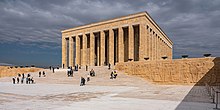
Mustafa Kemal became the republic's first president and introduced many reforms. The reforms aimed to transform the old religion-based and multi-communal Ottoman monarchy into a Turkish nation state that would be governed as a parliamentary republic under a secular constitution.[181] With the Surname Law of 1934, the Turkish Parliament bestowed upon Kemal the honorific surname "Atatürk" (Father Turk).[172] Atatürk's reforms caused discontent in some Kurdish and Zaza tribes leading to the Sheikh Said rebellion in 1925[182] and the Dersim rebellion in 1937.[183]
İsmet İnönü became the country's second president following Atatürk's death in 1938. In 1939, the Republic of Hatay voted in favor of joining Turkey with a referendum. Turkey remained neutral during most of World War II but entered the war on the side of the Allies on 23 February 1945. Later that year, Turkey became a charter member of the United Nations.[184] In 1950 Turkey became a member of the Council of Europe. After fighting as part of the UN forces in the Korean War, Turkey joined NATO in 1952, becoming a bulwark against Soviet expansion into the Mediterranean.
The country's transition to multi-party democracy was interrupted by military coups in 1960 and 1980, as well as by military memorandums in 1971 and 1997.[185][186] Between 1960 and the end of the 20th century, the prominent leaders in Turkish politics who achieved multiple election victories were Süleyman Demirel, Bülent Ecevit and Turgut Özal. Tansu Çiller became the first female prime minister of Turkey in 1993. Turkey entered EU Customs Union in 1995 and started accession negotiations with EU in 2005.[187]

In 2014, prime minister Recep Tayyip Erdoğan won Turkey's first direct presidential election.[188] On 15 July 2016, an unsuccessful coup attempt tried to oust the government.[189] With a referendum in 2017, the parliamentary republic was replaced by an executive presidential system. The office of the prime minister was abolished, and its powers and duties were transferred to the president. On the referendum day, while the voting was still underway, the Supreme Electoral Council lifted a rule that required each ballot to have an official stamp.[190] The opposition parties claimed that as many as 2.5 million ballots without a stamp were accepted as valid.[190]
Administrative divisions
Turkey has a unitary structure in terms of public administration, and the provinces are subordinate to the central government in Ankara. In province centers the government is represented by the province governors (vali) and in towns by the governors (kaymakam). Other senior public officials are also appointed by the central government, except for the mayors (belediye başkanı) who are elected by the constituents.[191] Turkish municipalities have local legislative bodies (belediye meclisi) for decision-making on municipal issues.
Turkey is subdivided into 81 provinces (il or vilayet) for administrative purposes. Each province is divided into districts (ilçe), for a total of 973 districts.[192] Turkey is also subdivided into 7 regions (bölge) and 21 subregions for geographic, demographic and economic measurements, surveys and classifications; this does not refer to an administrative division.
Government and politics
Turkey is a presidential republic within a multi-party system.[193] The current constitution was approved by referendum in 1982, which determines the government's structure, lays forth the ideals and standards of the state's conduct, and sets out the state's responsibility to its citizens. Furthermore, the constitution specifies the people's rights and obligations, as well as principles for the delegation and exercise of sovereignty that belongs to the people of Turkey.[194] Turkish politics have become increasingly associated with democratic backsliding, being described as a competitive authoritarian system.[195][196]
In the Turkish unitary system, citizens are subject to three levels of government: national, provincial, and local. The local government's duties are commonly split between municipal governments and districts, in which the executive and legislative officials are elected by a plurality vote of citizens by district. The government comprises three branches: first is legislative branch, which is Grand National Assembly of Turkey;[197] second is executive branch, which is the President of Turkey;[198] and third is the judicial branch, which includes the Constitutional Court, the Court of Cassation and Court of Jurisdictional Disputes.[199][5]
The Parliament has 600 voting members, each representing a constituency for a five-year term. Parliamentary seats are distributed among the provinces proportionally to the population. The president is elected by direct vote and serves a five-year term. The president cannot run for re-election after two terms of five-years, unless the parliament prematurely renews the presidential elections during the second term. Elections for the Parliament and presidential elections are held on the same day. The Constitutional Court is composed of 15 members. A member is elected for a term of 12 years and cannot be re-elected. The members of the Constitutional Court are obliged to retire when they are over the age of 65.[200]
Parties and elections
Elections in Turkey are held for six functions of government: presidential elections (national), parliamentary elections (national), municipality mayors (local), district mayors (local), provincial or municipal council members (local) and muhtars (local). Apart from elections, referendums are also held occasionally. Every Turkish citizen who has turned 18 has the right to vote and stand as a candidate at elections. Universal suffrage for both sexes has been applied throughout Turkey since 1934. In Turkey, turnout rates of both local and general elections are high compared to many other countries, which usually stands higher than 80%.[201]
The Constitutional Court can strip the public financing of political parties that it deems anti-secular or having ties to terrorism, or ban their existence altogether.[202][203] The electoral threshold for political parties at national level is seven percent of the votes.[204] Smaller parties can avoid the electoral threshold by forming an alliance with other parties. Independent candidates are not subject to an electoral threshold.
On the right side of the Turkish political spectrum, parties like the Democrat Party, Justice Party, Motherland Party, and Justice and Development Party became the most popular political parties in Turkey, winning numerous elections. Turkish right-wing parties are more likely to embrace the principles of political ideologies such as conservatism, nationalism or Islamism.[205] On the left side of the spectrum, parties like the Republican People's Party, Social Democratic Populist Party and Democratic Left Party once enjoyed the largest electoral success. Left-wing parties are more likely to embrace the principles of socialism, Kemalism or secularism.[206]
President Recep Tayyip Erdoğan, winner of the 2023 presidential election,[207][208] is currently serving as the head of state and head of government. Özgür Özel is the Main Opposition Leader. Numan Kurtulmuş is the Speaker of the Grand National Assembly. The 2023 parliamentary election resulted in the 28th Parliament of Turkey, which had an initial composition of 268 seats for the Justice and Development Party, 169 seats for the Republican People's Party, 61 seats for the Party of Greens and the Left Future, 50 seats for the Nationalist Movement Party, 43 seats for the Good Party, 5 seats for the New Welfare Party and 4 seats for the Workers' Party of Turkey.[209] The next parliamentary election is scheduled to take place in 2028.
Law


With the founding of the Republic, Turkey adopted a civil law legal system, replacing Sharia-derived Ottoman law. The Civil Code, adopted in 1926, was based on the Swiss Civil Code of 1907 and the Swiss Code of Obligations of 1911. Although it underwent a number of changes in 2002, it retains much of the basis of the original Code. The Criminal Code, originally based on the Italian Criminal Code, was replaced in 2005 by a Code with principles similar to the German Penal Code and German law generally. Administrative law is based on the French equivalent and procedural law generally shows the influence of the Swiss, German and French legal systems.[210] Islamic principles do not play a part in the legal system.[211]
Law enforcement in Turkey is carried out by several agencies under the jurisdiction of the Ministry of Internal Affairs. These agencies are the General Directorate of Security, the Gendarmerie General Command and the Coast Guard Command.[212] In the years of government by the Justice and Development Party and Erdoğan, particularly since 2013, the independence and integrity of the Turkish judiciary has increasingly been said to be in doubt by institutions, parliamentarians and journalists both within and outside of Turkey, because of political interference in the promotion of judges and prosecutors and in their pursuit of public duty.[213][214][215]
Foreign relations
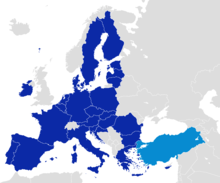
In line with its traditional Western orientation, relations with Europe have always been a central part of Turkish foreign policy. Turkey became one of the early members of the Council of Europe in 1950. Turkey applied for full membership of the EEC in 1987, joined the European Union Customs Union in 1995 and started accession negotiations with the European Union in 2005.[216][217] In a non-binding vote on 13 March 2019, the European Parliament called on the EU governments to suspend EU accession talks with Turkey, citing violations of human rights and the rule of law; but the negotiations, effectively on hold since 2018, remain active as of 2023.[218]
The other defining aspect of Turkey's foreign policy has been the country's long-standing strategic alliance with the United States.[219][220] The Truman Doctrine in 1947 enunciated American intentions to guarantee the security of Turkey and Greece during the Cold War, and resulted in large-scale U.S. military and economic support. In 1948 both countries were included in the Marshall Plan and the OEEC for rebuilding European economies.[221]

The common threat posed by the Soviet Union during the Cold War led to Turkey's membership of NATO in 1952, ensuring close bilateral relations with the US. Subsequently, Turkey benefited from the United States' political, economic and diplomatic support, including in key issues such as the country's bid to join the European Union.[222] In the post–Cold War environment, Turkey's geostrategic importance shifted towards its proximity to the Middle East, the Caucasus and the Balkans.[223]
The independence of the Turkic states of the Soviet Union in 1991, with which Turkey shares a common cultural, historic and linguistic heritage, allowed Turkey to extend its economic and political relations deep into Central Asia.[224] The International Organization of Turkic Culture (TURKSOY) was established in 1993, and the Organization of Turkic States (OTS) was established in 2009.
Under the AKP government, Turkey's economy has grown rapidly and the country's influence has grown in the Middle East based on a strategic depth doctrine, also called Neo-Ottomanism.[225][226]
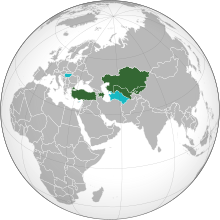
Following the Arab Spring in December 2010, the choices made by the government for supporting certain political opposition groups in the affected countries have led to tensions with some Arab states, such as Turkey's neighbor Syria since the start of the Syrian civil war, and Egypt after the ousting of President Mohamed Morsi.[227][228] As of 2022[update], Turkey does not have an ambassador in either Syria or Egypt,[229] but relations with both countries have started to improve.[230][231][232][233][234]
Diplomatic relations with Israel were also severed after the Gaza flotilla raid in 2010 but were normalized following a deal in June 2016.[235] These political rifts have left Turkey with few allies in the East Mediterranean, where large natural gas fields have recently been discovered.[236][237] There is a dispute over Turkey's maritime boundaries with Greece and Cyprus and drilling rights in the eastern Mediterranean.[238][239]
After the rapprochement with Russia in 2016, Turkey revised its stance regarding the solution of the conflict in Syria.[240][241][242] In January 2018, the Turkish military and the Turkish-backed forces, including the Syrian National Army,[243] began an operation in Syria aimed at ousting U.S.-backed YPG (which Turkey considers to be an offshoot of the outlawed PKK)[244][245] from the enclave of Afrin.[246][247] Turkey has also conducted airstrikes in Iraqi Kurdistan which have strained Turkey-Iraq relations as the latter has criticised the strikes for violating its sovereignty and killing civilians,.[248][249]
Military

The Turkish Armed Forces consist of the General Staff, the Land Forces, the Naval Forces and the Air Force. The Chief of the General Staff is appointed by the president. The president is responsible to the Parliament for matters of national security and the adequate preparation of the armed forces to defend the country. However, the authority to declare war and to deploy the Turkish Armed Forces to foreign countries or to allow foreign armed forces to be stationed in Turkey rests solely with the Parliament.[253]
The Gendarmerie General Command and the Coast Guard Command are under the jurisdiction of the Ministry of the Interior. Every fit male Turkish citizen otherwise not barred is required to serve in the military for a period ranging from three weeks to a year, dependent on education and job location.[254] Turkey does not recognize conscientious objection and does not offer a civilian alternative to military service.[255]
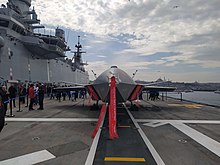
Turkey has the second-largest standing military force in NATO, after the United States, with an estimated strength of 890,700 military personnel as of February 2022.[264] Turkey is one of five NATO member states which are part of the nuclear sharing policy of the alliance, together with Belgium, Germany, Italy, and the Netherlands.[265] A total of 90 B61 nuclear bombs are hosted at the Incirlik Air Base, 40 of which are allocated for use by the Turkish Air Force in case of a nuclear conflict, but their use requires the approval of NATO.[266] The Turkish Armed Forces have a relatively substantial military presence abroad,[267] with military bases in Albania,[268] Iraq,[269] Qatar,[270] and Somalia.[271] The country also maintains a force of 36,000 troops in Northern Cyprus since 1974.[272]
Turkey has participated in international missions under the United Nations and NATO since the Korean War, including peacekeeping missions in Somalia, Yugoslavia and the Horn of Africa. It supported coalition forces in the First Gulf War, contributed military personnel to the International Security Assistance Force in Afghanistan, and remains active in Kosovo Force, Eurocorps and EU Battlegroups.[273][274] In recent years, Turkey has assisted Peshmerga forces in northern Iraq and the Somali Armed Forces with security and training.[275][276]
Human rights
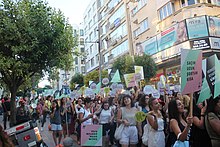
The human rights record of Turkey has been the subject of much controversy and international condemnation. Between 1959 and 2011 the European Court of Human Rights made more than 2,400 judgements against Turkey for human rights violations on issues such as Kurdish rights, women's rights, LGBT rights, and media freedom.[277][278] Turkey's human rights record continues to be a significant obstacle to the country's membership of the EU.[279]
In the latter half of the 1970s, Turkey suffered from political violence between far-left and far-right militant groups, which culminated in the military coup of 1980.[280] The Kurdistan Workers' Party (PKK, designated a terrorist organization by Turkey, the United States,[281] and the European Union[282]) was founded in 1978 by a group of Kurdish militants led by Abdullah Öcalan, seeking the foundation of an independent Kurdish state based on Marxist–Leninist ideology.[283] The initial reason given by the PKK for this was the oppression of Kurds in Turkey.[284][285] A full-scale insurgency began in 1984, when the PKK announced a Kurdish uprising. With time the PKK modified its demands into equal rights for ethnic Kurds and provincial autonomy within Turkey.[286][287][288][289] Since 1980, the Turkish parliament stripped its members of immunity from prosecution, including 44 deputies most of which from the pro-Kurdish parties.[290]
In 2013, widespread protests erupted, sparked by a plan to demolish Gezi Park but soon growing into general anti-government dissent.[291] On 20 May 2016, the Turkish parliament stripped almost a quarter of its members of immunity from prosecution, including 101 deputies from the pro-Kurdish HDP and the main opposition CHP party.[292][293] By 2020, under the pretext of responding to a failed coup attempt in 2016,[294][295] authorities had arrested or imprisoned more than 90,000 Turkish citizens.[296] According to the Committee to Protect Journalists, the AKP government has waged crackdowns on media freedom.[297][298] Many journalists have been arrested using charges of "terrorism" and "anti-state activities".[299][300] In 2020, the CPJ identified 18 jailed journalists in Turkey (including the editorial staff of Cumhuriyet, Turkey's oldest newspaper still in circulation).[301]
LGBT rights
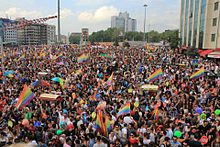
Homosexual activity has been decriminalized in Turkey since 1858.[303] LGBT people have had the right to seek asylum in Turkey under the Geneva Convention since 1951.[304] However, LGBT people in Turkey face discrimination, harassment and even violence.[305] The Turkish authorities have carried out many discriminatory practices.[306][307][308] Despite these, LGBT acceptance in Turkey is growing. In a survey conducted in 2016, 33% of respondents said that LGBT people should have equal rights, which increased to 45% in 2020. Another survey in 2018 found that the proportion of people who would not want a homosexual neighbor decreased from 55% in 2018 to 47% in 2019.[309][310] A 2015 poll found that 27% of the Turkish public was in favor of legalizing same-sex marriage and 19% supported civil unions instead.[311]
When the annual Istanbul Pride was inaugurated in 2003, Turkey became the first Muslim-majority country to hold a gay pride march.[312] Since 2015, parades at Taksim Square and İstiklal Avenue (where the Gezi Park protests took place) have been denied government permission, citing security concerns, but hundreds of people have defied the ban each year.[302] Critics have claimed that the bans were in fact ideological.[302]
Geography

Turkey bridges Southeastern Europe and Western Asia. Asian Turkey, which includes 97% of the country's territory, is separated from European Turkey by the Bosphorus, the Sea of Marmara, and the Dardanelles. European Turkey comprises 3% of the country's territory.[313] Turkey covers an area of 783,562 square kilometres (302,535 square miles),[314] of which 755,688 square kilometres (291,773 square miles) is in Asia and 23,764 square kilometres (9,175 square miles) is in Europe.[315] The country is encircled by seas on three sides: the Aegean Sea to the west, the Black Sea to the north and the Mediterranean Sea to the south. Turkey also contains the Sea of Marmara in the northwest.[316] The geographical centre of all land surfaces on Earth is at 39°00′N 34°00′E / 39.000°N 34.000°E, in Kırşehir Province.[317]
Turkey is divided into seven geographical regions: Marmara, Aegean, Black Sea, Central Anatolia, Eastern Anatolia, Southeastern Anatolia and the Mediterranean. As a general trend, the inland Anatolian Plateau becomes increasingly rugged as it progresses eastward.[316] Pamukkale terraces are made of travertine, a sedimentary rock deposited by mineral water from hot springs. The area is famous for a carbonate mineral left by the flowing of thermal spring water.[318][319]
East Thrace, the European portion of Turkey, is located at the easternmost edge of the Balkans. It forms the border between Turkey and its neighbors Greece and Bulgaria. The Asian part of the country mostly consists of the peninsula of Anatolia, which consists of a high central plateau with narrow coastal plains, between the Köroğlu and Pontic mountain ranges to the north and the Taurus Mountains to the south. The Lakes Region contains some of the largest lakes in Turkey such as Lake Beyşehir and Lake Eğirdir.
The Eastern Anatolia Region mostly corresponds to the western part of the Armenian highlands (the plateau situated between the Anatolian Plateau in the west and the Lesser Caucasus in the north)[320] and contains Mount Ararat, Turkey's highest point at 5,137 metres (16,854 feet),[321] and Lake Van, the largest lake in the country.[322] Eastern Turkey has a mountainous landscape and is home to the sources of rivers such as the Euphrates, Tigris and Aras. The Southeastern Anatolia Region includes the northern plains of Upper Mesopotamia.
Earthquakes happen frequently in Turkey and almost the entire population lives in areas with varying seismic risk levels.[37][323] Anatolian plate is bordered by North Anatolian Fault zone to the north; East Anatolian Fault zone and Bitlis–Zagros collision zone to the east; Hellenic and Cyprus subduction zones to the south; and Aegean extensional zone to the west.[324] After 1999 İzmit and 1999 Düzce earthquakes, North Anatolian Fault zone activity "is considered to be one of the most dangerous natural hazards in Turkey".[325] 2023 Turkey–Syria earthquakes were the deadliest in contemporary Turkish history.[326] Turkey is sometimes unfavorably compared to Chile, a country with a similar developmental level that is more successful with earthquake preparedness.[327][328][329]
Biodiversity

Turkey's position at the crossroads of the land, sea and air routes between the three Old World continents and the variety of the habitats across its geographical regions have produced considerable species diversity and a vibrant ecosystem.[330] Out of the 36 biodiversity hotspots in the world, Turkey includes 3 of them.[36] These are the Mediterranean, Irano-Anatolian, and Caucasus hotspots.[36]
The Northern Anatolian conifer and deciduous forests is an ecoregion which covers most of the Pontic Mountains in northern Turkey, while the Caucasus mixed forests extend across the eastern end of the range. The region is home to Eurasian wildlife such as the Eurasian sparrowhawk, golden eagle, eastern imperial eagle, lesser spotted eagle, Caucasian black grouse, red-fronted serin, and wallcreeper.[331] The narrow coastal strip between the Pontic Mountains and the Black Sea is home to the Euxine-Colchic deciduous forests, which contain some of the world's few temperate rainforests.[332] The Turkish pine (Pinus brutia) is mostly found in Turkey and other east Mediterranean countries. The forests of Turkey are home to the Turkey oak. The most commonly found species of the genus Platanus (plane) is the orientalis. Several wild species of tulip are native to Anatolia, and the flower was first introduced to Western Europe with species taken from the Ottoman Empire in the 16th century.[333][334]

There are 40 national parks, 189 nature parks, 31 nature preserve areas, 80 wildlife protection areas and 109 nature monuments in Turkey such as Gallipoli Peninsula Historical National Park, Mount Nemrut National Park, Ancient Troy National Park, Ölüdeniz Nature Park and Polonezköy Nature Park.[335] In the 21st century, threats to biodiversity include desertification from climate change in Turkey.[336]
The Anatolian leopard is still found in very small numbers in the northeastern and southeastern regions of Turkey.[337][338] The Eurasian lynx, the European wildcat and the caracal are other felid species which are found in the forests of Turkey. The Caspian tiger, now extinct, lived in the easternmost regions of Turkey until the latter half of the 20th century.[337][339] Renowned domestic animals from Ankara include the Angora cat, Angora rabbit and Angora goat; and from Van Province the Van cat. The national dog breeds are the Kangal (Anatolian Shepherd), Malaklı and Akbaş.[340]
Climate

The coastal areas of Turkey bordering the Aegean and Mediterranean Seas have a temperate Mediterranean climate, with hot, dry summers and mild to cool, wet winters.[342] The coastal areas bordering the Black Sea have a temperate oceanic climate with warm, wet summers and cool to cold, wet winters.[342] The Turkish Black Sea coast receives the most precipitation and is the only region of Turkey that receives high precipitation throughout the year.[342] The eastern part of the Black Sea coast averages 2,200 millimetres (87 in) annually which is the highest precipitation in the country.[342] The coastal areas bordering the Sea of Marmara, which connects the Aegean Sea and the Black Sea, have a transitional climate between a temperate Mediterranean climate and a temperate oceanic climate with warm to hot, moderately dry summers and cool to cold, wet winters.[342]
Snow falls on the coastal areas of the Sea of Marmara and the Black Sea almost every winter but usually melts in no more than a few days.[342] However, snow is rare in the coastal areas of the Aegean Sea and very rare in the coastal areas of the Mediterranean Sea.[342] Winters on the Anatolian plateau are especially severe. Temperatures of −30 to −40 °C (−22 to −40 °F) do occur in northeastern Anatolia, and snow may lie on the ground for at least 120 days of the year, and during the entire year on the summits of the highest mountains. In central Anatolia the temperatures can drop below −20 °C (−4 °F) with the mountains being even colder. Mountains close to the coast prevent Mediterranean influences from extending inland, giving the central Anatolian Plateau a continental climate with sharply contrasting seasons.[342]
Because of a combination of socioeconomic, population exposure, and climate factors, Turkey is highly vulnerable to climate change.[38]
Economy

Turkey is a founding member of the OECD and G20, and is classified among the E7 countries and EAGLEs. It is a newly industrialized country with an upper-middle income economy, which is the 17th-largest in the world by nominal GDP, and the 11th-largest by PPP. According to IMF estimates, Turkey's GDP per capita by PPP is $41,412 in 2023, while its nominal GDP per capita is $11,932.[8] Approximately 11.7% of Turks were at risk of poverty or social exclusion as of 2019.[343] Unemployment in Turkey was 10.4% in 2022.[344] According to the World Bank, the middle class population in Turkey rose from 18% to 41% of the total population between 1993 and 2010.[345]
As of October 2021[update], the foreign currency deposits of the citizens and residents in Turkish banks stood at $234 billion, equivalent to around half of all deposits.[346][347] As of March 2023[update], the foreign currency reserves of the Turkish Central Bank were $62.6 billion (a 2.3% increase compared to the previous month), its gold reserves were $52.2 billion (a 7.2% increase compared to the previous month), while its official reserve assets stood at $122.4 billion (a 4.3% increase compared to the previous month).[348]

The EU–Turkey Customs Union in 1995 led to an extensive liberalization of tariff rates, and forms one of the most important pillars of Turkey's foreign trade policy.[353] Foreign direct investment in Turkey peaked at $22.05 billion in 2007 and dropped to $13.09 billion in 2022.[354]
The automotive industry in Turkey is sizeable, and produced 1,352,648 motor vehicles in 2022, ranking as the 13th largest producer in the world.[355] Turkish automotive companies like TEMSA, Otokar and BMC are among the world's largest van, bus and truck manufacturers. Togg, or Turkey's Automobile Joint Venture Group Inc., is the first all-electric vehicle company of Turkey. Turkish shipyards are highly regarded both for the production of chemical and oil tankers up to 10,000 dwt and also for their mega yachts.[356] Turkish brands like Beko and Vestel are among the largest producers of consumer electronics and home appliances in Europe, and invest a substantial amount of funds for research and development in new technologies related to these fields.[357][358][359]
Other key sectors of the Turkish economy are banking, construction, home appliances, electronics, textiles, oil refining, petrochemical products, food, mining, iron and steel, and machine industry. According to a Turkish Statistical Institute survey in 2021, which used the available data for 2020, it was estimated that 47% of total disposable income was received by the top 20% of income earners, while the lowest 20% received only 6%.[360] Subsidies which are harmful to health in Turkey include those on sugar[361] and coal.[362]
Tourism

Tourism has increased almost every year in the 21st century[363] and is an important part of the economy. The Ministry of Culture and Tourism currently promotes tourism under the project Turkey Home. Turkey is one of the world's top five destination countries, with the highest percentage of foreign visitors arriving from Europe; specially Germany and Russia in recent years.[363] In 2022, Turkey ranked fourth in the world in terms of the number of international tourist arrivals with 50.5 million foreign tourists.[364] Turkey has 21 UNESCO World Heritage Sites and 84 World Heritage Sites in tentative list. Turkey is home to 519 Blue Flag beaches, third most in the world.[365] According to Euromonitor International report, Istanbul is the most visited city in the world, with more than 20.2 million foreign visitors in 2023.[366] Also Antalya has surpassed Paris and New York to become the fourth most visited city in the world, with more than 16.5 million foreign visitors.[366]
Infrastructure

In 2013 there were 98 airports,[367] including 22 international airports.[368] Istanbul Airport is planned to be the largest airport in the world, with a capacity to serve 150 million passengers per year.[369][370] Turkish Airlines uses Istanbul Airport, which has a current annual capacity of serving 90 million passengers, as its main hub and several other airlines operate in the country. Turkish Airlines has scheduled services to 315 destinations in 129 countries, making it the largest mainline carrier in the world by number of countries served.[371][372][373]
The motorway network spans 3,633 kilometres (2,257 mi) as of 2023,[374] with an expected expansion to 9,312 kilometres (5,786 miles) by 2035.[375] Istanbul Metro is the largest metro network in the country with 495 million annual ridership.[376] Opened in 2013, the Marmaray tunnel under the Bosphorus connects the railway and metro lines of Istanbul's European and Asian sides; while the nearby Eurasia Tunnel provides an undersea road connection for motor vehicles.[377]
The Bosphorus Bridge, Fatih Sultan Mehmet Bridge, and Yavuz Sultan Selim Bridge (2016) are the three suspension bridges connecting the European and Asian shores of the Bosphorus strait in Istanbul. The Çanakkale 1915 Bridge on the Dardanelles strait, connecting Europe and Asia, is the longest suspension bridge in the world.[378][379] The Osman Gazi Bridge connects the northern and southern shores of the Gulf of İzmit.

Turkish State Railways operates both conventional and high speed trains on 12,532 kilometres rail length. The government-owned national railway company started building high-speed rail lines in 2003. The Ankara-Konya line became operational in 2011, while the Ankara-Istanbul line entered service in 2014.[380] Konya-Karaman line started its operations in 2022 and 406 km (252 mi) long Ankara-Sivas line opened in 2023.[381]
Much energy in Turkey comes from Russia.[382] As of 2018[update] Turkey consumes 1,700 terawatt hours of primary energy per year, a little over 20 megawatt hours per person, mostly from imported fossil fuels.[383] Although the energy policy includes reducing fossil-fuel imports, coal in Turkey is the largest single reason why greenhouse gas emissions by Turkey amount to 1% of the global total. Renewable energy in Turkey is being increased and the Akkuyu Nuclear Power Plant is being built on the Mediterranean coast. However, despite the overcapacity in national electricity generation, fossil fuels are still subsidized.[384] In 2019 Turkey had the fourth-highest direct utilization and capacity of geothermal power in the world[385] and produced 43.8% of its electricity from renewable sources.[386]
Many natural gas pipelines span the country.[193] Blue Stream, a major trans-Black Sea gas pipeline, delivers natural gas from Russia as does the undersea pipeline TurkStream.[387] The Baku-Tbilisi-Ceyhan pipeline is the second longest oil pipeline in the world.[388] As of 2022, almost all gas is imported, but production from the Sakarya gas field, a sweet gas field in the Black Sea discovered by TPAO in 2020,[389] began in 2023,[390] with an estimated peak production of 40 bcm in 2026.[391] As of 2022, the total volume of natural gas discovered in the Black Sea amounted to 710 billion cubic metres (bcm).[392]
Science and technology

Turkey is among the top 50 most innovative countries in the world, ranking 39th in the Global Innovation Index in 2023; this represents a considerable increase since 2011, where it was ranked 65th.[394] TÜBİTAK is the leading agency for developing science, technology and innovation policies.[395] TÜBA is an autonomous scholarly society acting to promote scientific activities in Turkey.[396] TAEK is the country's official nuclear energy institution, focused on academic research and the development and implementation of peaceful nuclear technology.[397] It is supervising the construction of Turkey's first nuclear facility, Akkuyu Nuclear Power Plant in Mersin, at the cost of $20 billion; the plant became operational in 2023[398] and is projected to meet around 10% of the country's electricity demand.
The government invests heavily in research and development of military technologies, including Turkish Aerospace Industries, Aselsan, HAVELSAN, Roketsan, and MKE. Turkey is a global leader in unmanned aerial vehicles; the Bayraktar TB2, manufactured by private defence company Baykar, has been exported to over a dozen countries and played a decisive role in several conflicts, including the 2020 Nagorno-Karabakh war and the 2022 Russian invasion of Ukraine.[399][400]
In 2013, Turkey initiated the Turkish Space Launch System to develop an independent satellite launch capability[401][402][403] up to an altitude of 550 km (342 mi)[403] with the Roketsan Şimşek-1 rocket by 2027,[403] and the longer range Şimşek-2 by 2028,[403] including the construction of a spaceport, the development of satellite launch vehicles,[402][403] and the establishment of remote Earth stations.[404][405][406]
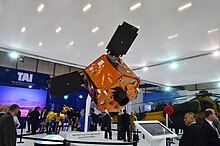
Türksat, the country's sole communications satellite operator, has launched a series of satellites into orbit; likewise, the Turkish Space Systems, Integration and Test Center—a spacecraft production and testing facility owned by the Ministry of National Defence and operated by the TAI—has launched the Göktürk series of Earth observation satellites for reconnaissance; BILSAT-1 and RASAT are the scientific Earth observation satellites operated by the TÜBİTAK Space Technologies Research Institute.
Turkish Antarctic Research Station is a planned research station in Antarctica. The plan is to build a permanent base for around 50 people, initially operating only during the summer, and later throughout all the year.[407]
In 2015, Aziz Sancar, a Turkish professor at the University of North Carolina, won the Nobel Prize in Chemistry for his work on how cells repair damaged DNA;[408] he is one of two Turkish Nobel laureates and the first in the sciences. Other prominent Turkish scientists include physician Hulusi Behçet, who discovered Behçet's disease; mathematician Cahit Arf, who defined the Arf invariant; and immunologists Uğur Şahin and Özlem Türeci, whose German biotechnology company, BioNTech, developed one of the first efficacious vaccines against COVID-19.
Demographics

According to the Address-Based Population Recording System, the country's population was 85,372,377 in 2023, excluding Syrians under temporary protection.[7] 93% lived in province and district centers.[7] In 2023, Turkey had an average population density of 111 people per km2.[7] People within the 15–64 age group constituted 68.3% of the total population; the 0–14 age group corresponded to 21.4%; while senior citizens aged 65 years or older made up 10.2%.[7] Between 1950 and 2020, Turkey's population more than quadrupled from 20.9 million to 83.6 million;[410] however, the population growth rate was 0.1% in 2023.[7]
Ethnicity

Article 66 of the Turkish Constitution defines a Turk as anyone who is a citizen.[412] It is estimated that there are at least 47 ethnic groups represented in Turkey.[413] Reliable data on the ethnic mix of the population is not available because census figures do not include statistics on ethnicity after the 1965 Turkish census.[414] According to the World Factbook, 70-75% of the country's citizens are ethnic Turks.[4] Based on a survey, KONDA's estimation was 76% in 2006, with 78% of adult citizens self-identifying their ethnic background as Turk.[415] In 2021, 77% of adult citizens identified as such in a survey.[416]
Kurds are the largest ethnic minority.[417] Their exact numbers remain disputed,[417] with estimates ranging from 12 to 20% of the population.[418] According to a 1990 study, Kurds made up around 12% of the population.[419] The Kurds make up a majority in the provinces of Ağrı, Batman, Bingöl, Bitlis, Diyarbakır, Hakkari, Iğdır, Mardin, Muş, Siirt, Şırnak, Tunceli and Van; a near majority in Şanlıurfa (47%); and a large minority in Kars (20%).[420] In addition, internal migration has resulted in Kurdish diaspora communities in all of the major cities in central and western Turkey. In Istanbul, there are an estimated three million Kurds, making it the city with the largest Kurdish population in the world.[421] 19% of adult citizens identified as ethnic Kurds in a survey in 2021.[416] Some people have multiple ethnic identities, such as both Turk and Kurd.[422][423] In 2006, an estimated 2.7 million ethnic Turks and Kurds were related from interethnic marriages.[424]
According to the World Factbook, non-Kurdish ethnic minorities are 7–12% of the population.[4] In 2006, KONDA estimated that non-Kurdish and non-Zaza ethnic minorities constituted 8.2% of the population; these were people that gave general descriptions such as Turkish citizen, people with other Turkic backgrounds, Arabs, and others.[415] In 2021, 4% of adult citizens identified as non-ethnic Turk or non-ethnic Kurd in a survey.[416] According to the Constitutional Court, there are only four officially recognized minorities in Turkey: the three non-Muslim minorities recognized in the Treaty of Lausanne (Armenians, Greeks, and Jews[c]) and the Bulgarians.[d][428][429][430] In 2013, the Ankara 13th Circuit Administrative Court ruled that the minority provisions of the Lausanne Treaty should also apply to Assyrians in Turkey and the Syriac language.[431][432][433] Other unrecognized ethnic groups include Albanians, Bosniaks, Circassians, Georgians, Laz, Pomaks, and Roma.[434][435][436] Turkey is also home to a Muslim community of Megleno-Romanians.[437]



